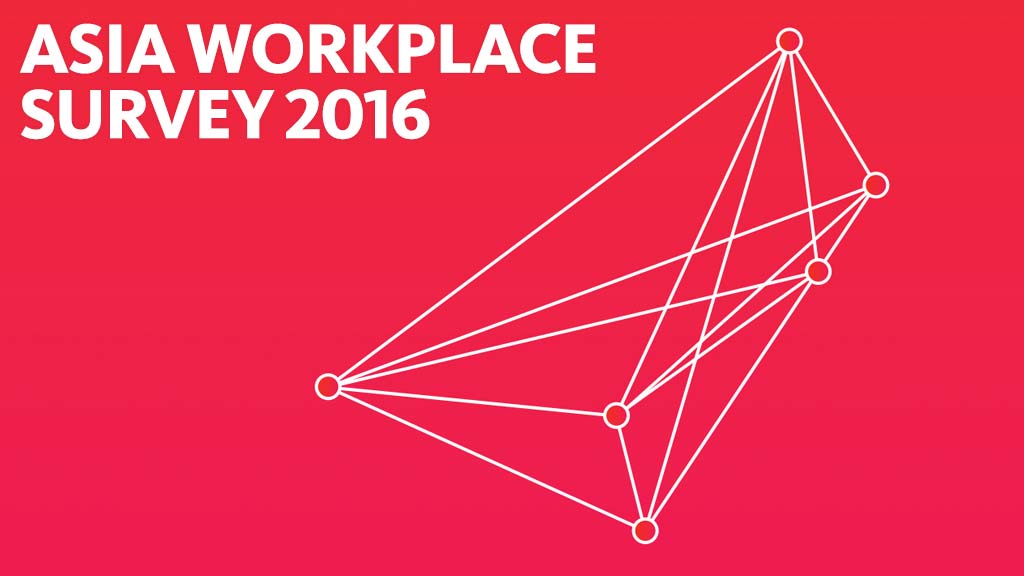Can Asian organizations embrace experimentation and balance to create a distinct workplace identity?
Asia Workplace Survey 2016
What We Did
Note: this report is part of an ongoing series of research on the workplace - view the latest China Workplace Survey here
We surveyed over 2,000 randomly sampled Asian office workers, focused in six major metropolitan areas—Bangalore, Beijing, Hong Kong, Shanghai, Singapore, and Tokyo—to understand the Asian workplace from the perspective of the worker.
The data collected represents respondents across nine key industries, and a wide distribution of ages and organizational roles. Survey questions explored not only the current state of the workplace—how, and where, employees are working and how effective those spaces are—but also organizational dynamics, including relationships with teams and managers, and the impact of hierarchy on employee performance and experience. Similar to surveys conducted in the US and UK, we gathered data using Gensler’s proprietary Workplace Performance Index (WPI) survey tool.
The Context
The Results
This desire for balance fits with cultural themes that unify Asia—from slokas in Sanskrit, to Buddha’s middle path, to the Chinese philosophy of Ying and Yang, the need for balance is deeply connected to culture and spirituality. For the respondents to our Asia workplace survey, the impact of achieving this balance in the workplace is also clear—respondents in balanced workplaces are more satisfied with their jobs, see their companies as more creative and innovative, have better relationships with their managers, and greater work-life balance.
Equally clear, however, is a desire among our respondents to seek new ways of working that push beyond the boundaries of the traditional, western workplace design and experience. Unlike the US and UK, in which a collaborative work environment proved to be a key statistical driver of organizational innovation alongside managerial relationships and meaning in one’s work, in Asia the key driver after meaning and relationships is feeling empowered to experiment with new ways of working. Flexibility in day-to-day job scope, and a lack of hierarchy in how workspaces are assigned, also prove important factors to Asian office workers today.
What This Means
Employees in balanced workplaces see their managers in a more positive light, are able to communicate more openly and honestly, better receive feedback, and reported higher work-life balance and job satisfaction. The quality of relationships is also a key factor in creating a culture of creativity and innovation at work.
Mobility enhances performance.
Employees in balanced workplaces spend an average of 20% less time in their primary workplace or office location, consistent across countries and industries. By having the capability and infrastructure to work outside of the office, they may also be able to shorten travel time in Asia’s larger urban centers, increasing their productive working time. Organizations should encourage employees to work from alternate settings, experimenting with not just the how but also the where of their work while at the same time, being sensitive to local culture and expectations.
Prioritize autonomy and choice. Employees who could choose their own work settings were 1.5 times more likely to work in a balanced environment, and also report higher scores across performance indicators. Choice in when and where to work, paired with a variety of spaces in which to work, is also a key aspect of empowered mobility and experimentation.
Experimentation helps innovation. The central theme of flexibility and the ability to experiment with new ways of working permeated the results of our Asia Workplace Survey. Empowering experimentation, and encouraging employees to take risks in search of new and better ways to work, is of paramount importance.
What’s Next?
Learn More
Team
Nachiko Yamamoto, Smita Gupta, Daichi Amano, Connie Ho, Amrapali Agarwal, Shravan Bendapudi, Caroline Burns, Lijun Cher, Fumi Mangyo, Arpita Ray, Taro Uchiyama, Lois Yang
Year Completed
2016
Comments or ideas for further questions we should investigate?
